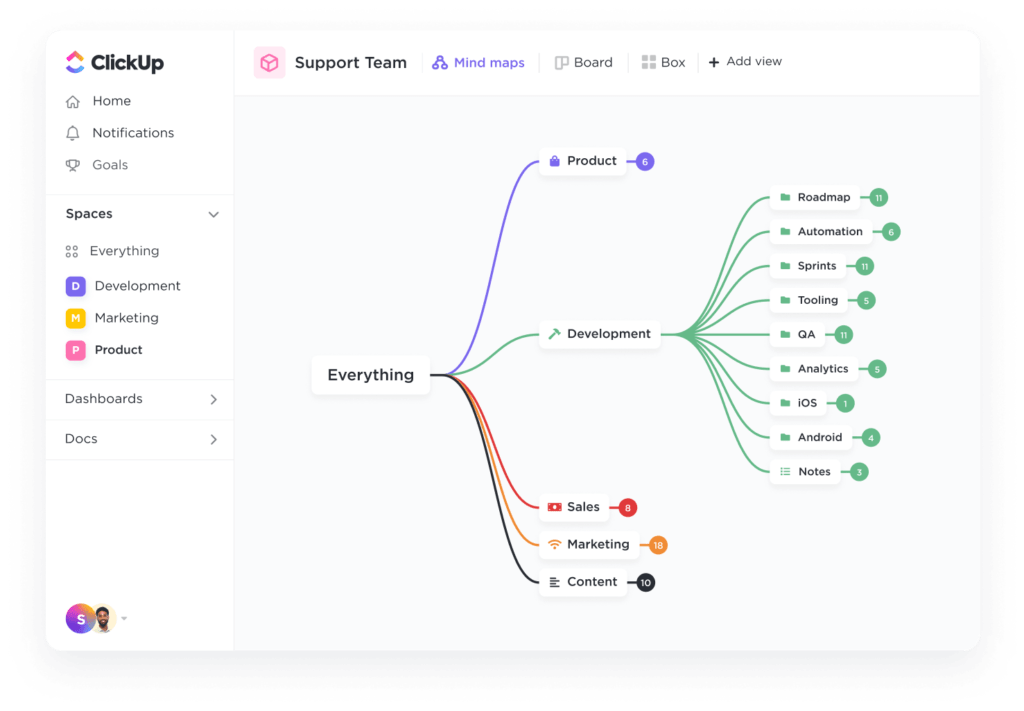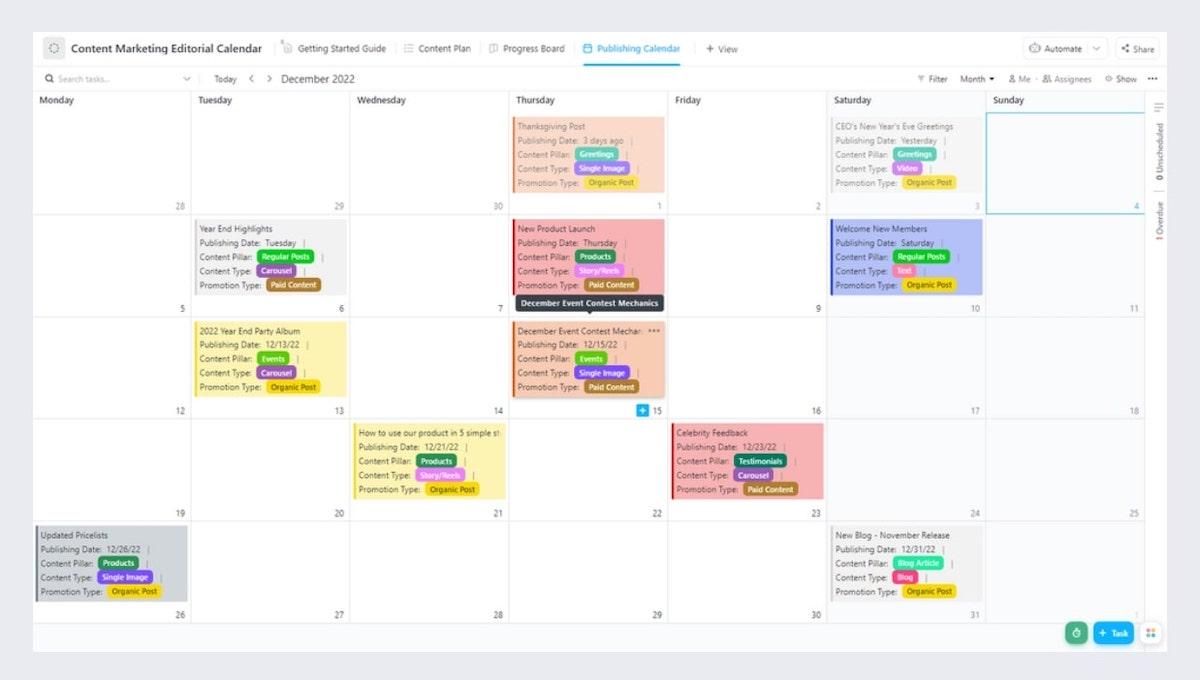كما يعلم أي مسوّق، فإن المحتوى عالي الجودة هو مفتاح النمو العضوي. ومع ذلك، لا يكفي مجرد إنشاء المحتوى - يجب عليك أيضًا التأكد من أن المحتوى الخاص بك يساهم في تحقيق أهداف المؤسسة.
يساعدك تدقيق المحتوى على تحديد أجزاء المحتوى التي تعمل بشكل جيد والأجزاء التي تحتاج إلى تحسين.
دعنا نستكشف هذا المفهوم أكثر قليلاً لفهم ماهية تدقيق المحتوى، وسبب أهميته لعملك، وكيف يمكنك بناء عملية مفصلة حوله.
ما هو تدقيق المحتوى؟
تدقيق محتوى الموقع الإلكتروني هو مراجعة شاملة لكل المحتوى على الموقع الإلكتروني لتقييم مدى ملاءمته واتساقه وفعاليته في تحقيق أهداف العمل. يتضمن تدقيق المحتوى ما يلي:
- فهرسة كل جزء من المحتوى
- تقييم المحتوى بناءً على معايير تدقيق محددة
- تحسينه لتحسين الأداء العام
تضمن عمليات التدقيق المنتظمة للمحتوى توافق إنشاء المحتوى مع أهداف قنواتك التسويقية وتحديث فرق العمل للمحتوى باستمرار.
أهم 5 فوائد لمراجعة محتوى الموقع الإلكتروني
يؤدي إجراء تدقيق المحتوى بشكل استراتيجي إلى تعزيز فعالية تواجدك على الإنترنت. فيما يلي أهم خمس فوائد لإجراء عمليات تدقيق منتظمة للمحتوى:
- تحسين جودة المحتوى: تساعد عمليات التدقيق المنتظمة للمحتوى في الحفاظ على معايير عالية من خلال ضمان دقة كل المحتوى وتحديثه وملاءمته لجمهورك
- تحسين أداء تحسين محركات البحث: تعمل عمليات تدقيق المحتوى على تحسين رؤية محرك البحث من خلال تحديد المحتوى القديم وتحديثه
- زيادة تفاعل الجمهور: تسمح لك عمليات تدقيق المحتوى بتحسين المحتوى بشكل أفضل لتلبية اهتمامات واحتياجات جمهورك
- استراتيجية محتوى مبسطة: تكشف عمليات تدقيق المحتوى عن الثغرات والتكرار في استراتيجية المحتوى الخاصة بك. وهذا يسمح بتخطيط وتخصيص الموارد بشكل أكثر فعالية
- قرارات قائمة على البيانات: توفر عمليات تدقيق المحتوى رؤى قيمة حول أنواع المحتوى الأفضل أداءً. وهذا يوجه استراتيجيات إنشاء المحتوى واستراتيجيات التسويق في المستقبل
اقرأ أيضًا: طرق العصف الذهني للمحتوى التي يمكنك استخدامها اليوم
### متى يتم إجراء تدقيق المحتوى
يؤدي إجراء تدقيق المحتوى على فترات استراتيجية إلى تعزيز فعالية خطة المحتوى الخاصة بك. فيما يلي بعض الأوقات المثالية للنظر في إجراء تدقيق المحتوى:
- سنوياً: يساعد التدقيق السنوي للمحتوى على ضمان أن يظل المحتوى الخاص بك متوافقًا مع أهداف عملك المتطورة وديناميكيات السوق
- بعد تغيير العلامة التجارية: بعد تغيير علامتك التجارية، من الضروري مواءمة كل المحتوى مع هوية علامتك التجارية الجديدة وصوتها ورسائلها للحفاظ على الاتساق
- قبل إطلاق حملة تسويقية كبرى: قبل إطلاق الحملات التسويقية الكبرى، تعمل مراجعة المحتوى على تحسين المحتوى الحالي لضمان دعم مبادراتك القادمة وتضخيمها
- عندما تقوم بتوسيع عروضك: إذا كانت شركتك بصدد تقديم منتجات أو خدمات جديدة، فإن تدقيق المحتوى يساعد في تحديد ثغرات المحتوى المتعلقة بهذه العروض الجديدة، مما يضمن دعم المحتوى الخاص بك لجهود المبيعات والتسويق
- بعد التحديثات الهامة لتحسين محركات البحث أو الخوارزميات: عندما تقوم محركات البحث بتحديث خوارزمياتها، فإن مراجعة المحتوى الخاص بك للتأكد من توافقه مع تحسين محركات البحث تمنع انخفاض تصنيفات البحث وحركة المرور
💡 نصيحة احترافية: قم بإحداث تأثير أكبر من خلال عمليات تدقيق المحتوى الخاص بك عن طريق زيادة خطة إدارة تسويق المحتوى .
## كيفية إجراء تدقيق المحتوى
الخطوات الأساسية لإجراء تدقيق ناجح للمحتوى موضحة أدناه، ولكن تأكد من تكييف نموذج تدقيق المحتوى والعملية بعناية مع متطلبات عملك.
الخطوة 1: حدد أهداف تدقيق المحتوى الخاص بك
فكر في الأهداف التي تريد أن يحققها مخزون المحتوى الخاص بك: سيساعدك هذا على تخطيط تدقيق المحتوى الخاص بك بشكل أفضل.
إذا كان هدفك هو توسيع نطاق عمليات المحتوى الخاص بك ، يجب أن يحدد تدقيق المحتوى المجالات التي تعمل فيها الأتمتة على تسريع إنتاج المحتوى دون التضحية بالجودة. يمكنك أيضًا تقييم مدى استفادة محتواك الحالي من تحسين محركات البحث ووسائل التواصل الاجتماعي لزيادة الوصول إلى أقصى حد ممكن.
وبالتالي، سيكون هدف تدقيق المحتوى الخاص بك هو تقييم كفاءة سير عمل المحتوى وفعالية المحتوى الخاص بك في إشراك الجماهير على نطاق واسع.
تحديد الهدف مع ClickUp
بمجرد أن تقرر أهداف تدقيق المحتوى الخاص بك، قم بتنظيمها باستخدام أهداف ClickUp .
وهذا يتيح لك بسهولة تحديد أهداف تدقيق المحتوى الخاص بك، وتقسيمها إلى أهداف أصغر، وتتبع تقدمها، وتعيين مهام مختلفة لأعضاء الفريق تتعلق بكل هدف. يجعل ClickUp من السهل للغاية إدارة الأهداف المعقدة ومراقبة التحديثات على عناصر العمل.

اعمل مع جداول زمنية واضحة وأهداف قابلة للقياس باستخدام أهداف ClickUp Goals
الخطوة 2: جرد المحتوى الخاص بك
بمجرد أن تحدد الأهداف، فإن الخطوة التالية في تدقيق المحتوى هي فهرسة كل المحتوى الموجود إنشاء قاعدة بيانات شاملة للمحتوى لكل جزء من المحتوى الذي يستضيفه موقعك على الويب، بما في ذلك منشورات المدونة وصفحات الموقع وملفات الوسائط المتعددة وأي محتوى قابل للتنزيل مثل ملفات PDF والأوراق البيضاء.
على سبيل المثال، يمكنك تجميع قائمة تتضمن كل منشور في المدونة مع عنوان صفحته، مصنفة حسب الموضوع.
وبالمثل، قم بتنظيم الصفحات المقصودة حسب مرحلة التحويل، مع تفصيل عناصر تحسين محركات البحث على الصفحة مثل الأوصاف الوصفية وعلامات الرأس.
بالنسبة لملفات الوسائط المتعددة، قم بتصنيفها حسب النوع، وقم بتقييم مقاييس المشاركة إلى جانب أي عوامل مرتبطة بتحسين محركات البحث على الصفحة.
🔥مكافأة: دليل ديفين ريد لتوسيع نطاق المحتوى باستخدام الذكاء الاصطناعي
بناء كتالوج المحتوى الخاص بك باستخدام طريقة عرض الجدول في ClickUp
قم بتنظيم بيانات المحتوى الخاص بك في جداول متجاوبة مع أنواع حقول متعددة في عرض جدول ClickUp Table . ربط المهام والمستندات وإضافة مرفقات وإنشاء حقول مخصصة لتسجيل البيانات مثل الفئة والمؤلف وحركة المرور وما إلى ذلك. مع التنظيم البسيط بالسحب والإفلات وخيارات الفرز والتصفية، يصبح دمج بيانات التدقيق أسهل بكثير في ClickUp.
إليك كيفية فهرسة أصول المحتوى الخاص بك بكفاءة بطريقة يمكن إدارتها في ClickUp:
- استخدم الأدوات الآلية لكشط موقعك الإلكتروني وإنشاء قائمة بعناوين URL تلقائيًا.
- تحقق يدويًا من بيانات تدقيق المحتوى لضمان الدقة والتقاط أي محتوى قد تفوته الأدوات الآلية
- تحويل هذه المعلومات إلىمهام ClickUp مع تحميل ملف CSV بسيط، وتطبيق طريقة عرض الجدول. صنف المحتوى حسب النوع والمؤلف وتاريخ الإنشاء ومقاييس الأداء مثل مشاهدات الصفحة أو معدلات المشاركة
- تحديد المحتوى المكرر والقديم وتحديثه أو إزالته لتحسين تحسين محركات البحث على الصفحة وتجربة المستخدم
اقرأ أيضًا: أفضل برامج وكالات تحسين محركات البحث
الخطوة 3: تحليل أداء المحتوى
الخطوة التالية هي استخدام تحليلات الموقع الإلكتروني لتقييم مدى جودة أداء المحتوى الخاص بك.
يساعد هذا التحليل على تحديد المحتوى الذي يلقى صدى لدى جمهورك والمحتوى الذي لا يلقى صدى، مما يتيح اتخاذ قرارات مستنيرة بشأن تحسين المحتوى أو إزالته.
في ClickUp، نحن نعرف كل شيء عن إنشاء محتوى يؤدي - على نطاق واسع! يشاركنا جيريمي جالانتي، الذي يقود تحسين محركات البحث في ClickUp، كيفية تحليل أداء المحتوى الخاص بك وما يجب القيام به بعد ذلك.
أ. التحقق من ترتيب SERP
- تتمثل الخطوة الأولى في التحقق مما إذا كان المحتوى الخاص بك (مقالات المدونة، في هذه الحالة) يحتل مرتبةً في بحث جوجل للكلمات الرئيسية المستهدفة. إذا كان كذلك، فانتقل إلى تحسينات الأداء
- إذا لم يتم تصنيف المدونة كما هو متوقع بعد فترة زمنية معينة (لنقل 90 يومًا) أو لم تتم فهرستها، فضع علامة تحسين الأداء. في ClickUp، يلتقط سير العمل التلقائي كل هذه المقالات لتحسينها
- قد ينطوي تحسين المحتوى على تحديثات أو إعادة كتابة كبيرة أو حتى الاستغناء عن أجزاء معينة تمامًا. يعتمد هذا القرار على أهمية الموضوع، وإمكانيات المقالة، وتقييمك لمدى إمكانية الفوز بها
ب. إجراء تحسينات على الأداء
بمجرد تحديد المرشحين للتحسين، إليك ما يجب القيام به بعد ذلك:
تحسين المحتوى بناءً على المقياس الذي ترغب في تحسينه. على سبيل المثال، إذا كان هناك مجال لزيادة عدد الزيارات، فاعمل على تحسين الترتيب في البحث، أي تحسينات في تحسينات تحسينات تحسين محركات البحث
إذا كانت هناك إمكانية لزيادة التحويلات، استثمر الوقت في أنشطة تحسين معدل التحويلات (CRO)، بما في ذلك تحسين وضع منتجك
قم بتحليل كل قطعة لثلاثة مقاييس: حركة المرور، والتحويلات، وجودة التحويلات
إليك نصيحة من جيريمي حول كيفية النظر إلى تحسين المحتوى:
ليس من الضروري أن يكون أداء المقال سيئًا حتى يتم تحسينه. على سبيل المثال، قد تكون المقالة التي يتم ترتيبها في الموضع 3 أو 4 تولد حركة مرور وتحويلات، ولكن غالبًا ما يكون الجانب الإيجابي لنقلها إلى الموضع 1 أو 2 أكبر بكثير مقارنةً بالمقالة التي لا تزال تقاتل من أجل الحصول على موضع في الصفحة الأولى.
جيريمي جالانتي، مدير تحسين محركات البحث، ClickUp
💡 نصيحة احترافية: مثل فريق ClickUp، يمكنك أيضًا إعداد مهام سير العمل التلقائية مع أتمتة ClickUp لإنشاء مهام تحسين للمحتوى منخفض الأداء.
استخدام لوحات معلومات ClickUp لتحليل بيانات تدقيق المحتوى

استفد من لوحات معلومات ClickUp Dashboards للحصول على رؤى مستندة إلى البيانات لتحسين استراتيجية المحتوى الخاص بك لوحات معلومات ClickUp Dashboards طريقة فعالة لتصور مقاييس أداء المحتوى وتحليلها. تتيح لك لوحات المعلومات هذه إنشاء طرق عرض مخصصة لبياناتك ومراقبة أداء المحتوى الخاص بك عبر مقاييس مختلفة.
قم بتخصيصها لتسليط الضوء على نقاط البيانات الرئيسية ذات الصلة بمراجعة المحتوى الخاص بك، مثل اتجاهات حركة المرور ومعدلات المشاركة وإحصائيات التحويل.
وهذا يجعل من السهل اكتشاف الاتجاهات، وتحديد ما هو ناجح، وتحديد المجالات التي تحتاج إلى تعزيز أو إصلاح شامل. باستخدام لوحات معلومات ClickUp Dashboards:
- عرض مقاييس المحتوى الرئيسية في الوقت الفعلي
- تتبع التغييرات في المشاركة وأداء تحسين محركات البحث
- مواءمة استراتيجية المحتوى الخاص بك مع رؤى سلوك الجمهور
- تبسيط إعداد التقارير من خلال تجميع البيانات وتصورها تلقائيًا
💡 نصيحة احترافية: استخدم عرض تضمين ClickUp لجلب البيانات من أوراق وأدوات متعددة في لوحة تحكم واحدة!
الخطوة 4: اكتشف الثغرات واغتنم الفرص
دمج تحديد الاتجاهات التقنيات لتحديد الموضوعات الناشئة ومجالات الاهتمام. وهذا يضمن أن المحتوى الخاص بك لا يسدّ الثغرات الحالية فحسب، بل يتوقع أيضًا الاتجاهات المستقبلية، مما يجعل علامتك التجارية رائدة في مجال عملك.
استخدم أيضًا أدوات تحليل المنافسين لمعرفة ما يقومون به بشكل جيد قد يفوتك.
على سبيل المثال، إذا كنت تفتقد إلى أدلة إرشادية حول الموضوعات الشائعة، وأنت تعلم أن جميع المواقع الإلكترونية المنافسة لديك تحتوي على هذه الأدلة، فهذه فجوة يجب سدها. يمكن بالتأكيد زيادة المشاركة والسلطة.
تعزيز استراتيجية المحتوى باستخدام قالب تحليل الثغرات من ClickUp
نموذج ClickUp لتحليل الفجوة
قالب تحليل الثغرات في ClickUp يحوِّل المهمة الشاقة المتمثلة في تحديد أوجه القصور في المحتوى إلى عملية منظمة وسهلة الإدارة. فهو يساعدك على تحديد المواضع التي تحتاج استراتيجيتك إلى تعزيزها ويضع فريقك على طريق التحسين. يساعدك هذا النموذج على
- تصور ثغرات الأداء مقابل أهداف المحتوى الخاص بك من خلال جدول بيانات تدقيق المحتوى الشامل
- تحديد أولويات تحديثات المحتوى والمواضيع الجديدة بناءً على الاحتياجات المحددة
- مواءمة جهود تطوير المحتوى بشكل استراتيجي مع متطلبات الجمهور
الخطوة 5: قم بصياغة خطة عملك
بمجرد الانتهاء من كل شيء، شمر عن ساعديك وارسم مسارًا واضحًا للمضي قدمًا. ابدأ بتحديد خطوات محددة لتحديث المحتوى القديم، أو زيادة عدد الكلمات، أو إزالة التكرار، أو إنشاء محتوى جديد.
إليك كيفية التعامل مع كل مجال:
- التحديثات: استخدم أدوات تدقيق المحتوى لتحديد الأجزاء الرئيسية من المحتوى التي تعمل بشكل جيد ولكن يمكن أن تستخدم طبقة جديدة من الطلاء. ربما تكون هناك بيانات جديدة أو روابط داخلية يجب تضمينها، أو ربما يمكن تعديل البنية أو الوصف التعريفي لتحسين محركات البحث. ضع قائمة بالتغييرات المطلوبة وحدد مواعيد نهائية لإبقاء تحديثاتك على المسار الصحيح
- عمليات الإزالة: تخلص من الفوضى. إذا كان هناك محتوى معين لا يجلب قيمة أو حركة مرور، فقد حان الوقت للتخلي عنه. سيساعد ذلك على تحسين الجودة الإجمالية لموقعك وتحسين تجربة المستخدم
- محتوى جديد: قم بعصف ذهني للأفكار التي تتماشى مع اهتمامات جمهورك ونية البحث. استخدم الثغرات التي حددتها لتوجيه موضوعاتك. خطط لتقويم المحتوىوتعيين الكتاب والمصممين، وتحديد المواعيد النهائية
اقرأ أيضًا: كيفية استخدام الذكاء الاصطناعي في تسويق المحتوى
الأدوات الأساسية لمراجعة المحتوى
يتطلب إجراء تدقيق شامل للمحتوى أدوات متقدمة لتحليل صفحات الويب، وجمع البيانات حول أداء المحتوى، والكشف عن فرص تحسين محركات البحث. إليك بعض الأدوات الأساسية لتبسيط عملية تدقيق المحتوى:
1. تحليلات جوجل

عبر دعم جوجل هذا أمر لا بد منه لأي مسوّق للمحتوى. Google Analytics هي أداة مجانية تحلل موقعك الإلكتروني بالكامل وتوفر رؤى حول حركة المرور على موقعك الإلكتروني، وسلوك المستخدم، والصفحات الأعلى تصنيفًا، ومقاييس المشاركة.
استخدمها لتحديد أفضل صفحاتك المقصودة أداءً، وفهم مصدر الزيارات العضوية لموقعك الإلكتروني، ومعرفة كيفية تفاعل المستخدمين مع المحتوى الخاص بك.
2. Ahrefs

عبر Ahrefs أداة قوية لدعم استراتيجية تسويق المحتوى الخاص بك، يتيح لك موقع Ahrefs البحث عن حركة مرور منافسيك على موقعك الإلكتروني.
فهي تمكّن المستخدمين من معرفة ما الذي ينجح معهم، وتتبع أهم صفحاتهم، وفهم عدد الروابط الخلفية التي يمتلكونها.
كما أنها رائعة أيضًا للعثور على ثغرات المحتوى وفرص الكلمات الرئيسية.
3. Screaming Frog SEO Spider

عبر الضفدع الصارخ هذه الأداة ممتازة للزحف إلى موقعك الإلكتروني لمحاكاة كيفية عرض محركات البحث لموقعك. وهي تساعد في تحديد مشكلات تحسين محركات البحث مثل الروابط المعطلة والمحتوى المكرر والبيانات الوصفية المفقودة، وهي أمور ضرورية للحفاظ على موقع إلكتروني سليم.
بالإضافة إلى ذلك, دمج أدوات الذكاء الاصطناعي للبحث عن الكلمات المفتاحية يحسّن استراتيجيتك بشكل أكبر من خلال الكشف عن الكلمات المفتاحية القيّمة التي تجذب المزيد من الزيارات وتعزز ملاءمة المحتوى.
4. ClickUp ClickUp لفرق التسويق عبارة عن منصة متعددة الاستخدامات لإدارة المشاريع، وهي منصة متعددة الاستخدامات لإدارة المشاريع، وهي مركز قوة لفرق المحتوى. تتفوق في
إنشاء المحتوى والتحليل والإدارة ويساعد على تبسيط دورة حياة المحتوى بالكامل، بدءًا من العصف الذهني للأفكار وصياغة المقالات إلى النشر والتحليل بعد النشر.
تدعم المنصة مختلف أنواع المحتوى، مما يتيح التعاون السلس بين الكتّاب والمحررين والمسوقين.
تقدم ClickUp أيضًا قوالب متعددة (على سبيل المثال, قوالب كتابة المحتوى أو قوالب استراتيجية تسويق المحتوى ) لتبسيط تخطيط جهودك في تخطيط المحتوى وتنفيذه.
دعنا نلقي نظرة على بعض ميزات ClickUp البارزة بالإضافة إلى الميزات التي أشرنا إليها سابقاً.
إنشاء محتوى شامل باستخدام مستندات ClickUp

تبسيط إنشاء المحتوى والتعاون مع مستندات ClickUp Docs مستندات ClickUp Docs يعمل على تبسيط عملية إنشاء المحتوى الخاص بك، مما يسهل عملية الصياغة والتحرير والتعاون في مكان واحد. سواء كنت تقوم بصياغة منشورات مدونة أو تقارير مفصلة أو مواقع الويكي الداخلية، فإن ClickUp Docs يتكيف مع احتياجاتك بخيارات تنسيق غنية وميزات تعاون في الوقت الفعلي.
قم بدمج مستنداتك بسلاسة مع المهام وسير العمل، مما يضمن انتقال المحتوى الخاص بك بسلاسة من الفكرة إلى النشر.
مع ClickUp Docs:
- تعاون في الوقت الفعلي، وقم بوضع علامات على أعضاء الفريق للحصول على تعليقاتهم
- تحويل أجزاء من مستنداتك إلى مهام قابلة للتتبع
- الحفاظ على التحكم في الإصدار لتتبع التعديلات والتحديثات
- مشاركة المستندات بشكل آمن مع مستويات وصول مختلفة لأعضاء الفريق أو الشركاء الخارجيين
تسريع إنشاء المحتوى وتحليل التدقيق باستخدام ClickUp Brain

تعزيز تحليل المحتوى باستخدام إمكانات الذكاء الاصطناعي في ClickUp Brain ClickUp Brain هو مصدر قوة الذكاء الاصطناعي الخاص بك، حيث يعمل على تحسين طريقة إدارتك لإنشاء المحتوى وعمليات التدقيق. لا تساعدك هذه الأداة على الكتابة فحسب؛ بل تربط جميع معارف شركتك - المهام والمستندات والاتصالات - في شبكة ذكية واحدة.
مع ClickUp Brain:
- استعلم عن مستنداتك ومهامك للعثور على المعلومات على الفور باستخدام مدير المعرفة بالذكاء الاصطناعي
- أتمتة مهام إدارة مشروع المحتوى باستخدام AI Project Manager
- قم بصياغة المحتوى وتنقيحه باستخدام كاتب الذكاء الاصطناعي للعمل
- تتبع أداء المحتوى والتحديثات وتحليلها عبر المنصات
رسم خطة المحتوى الخاص بك وتخطيطها وتنفيذها باستخدام ClickUp Whiteboards

_حَوِّل جلسات العصف الذهني إلى استراتيجيات قابلة للتنفيذ مع لوحات ClickUp Whiteboards ClickUp Whiteboards حوّل جلسات العصف الذهني لفريقك إلى استراتيجيات قابلة للتنفيذ، كل ذلك في مساحة افتراضية ديناميكية وتعاونية. ارسم، ودوّن الملاحظات، واربط الأفكار بصريًا بالمهام والمشاريع الفعلية، مما يضمن عدم إهمال أي فكرة.
مع سبورة ClickUp Whiteboards:
- ارسم موضوعات المحتوى واربطها بالحملات التسويقية
- تنظيم مخرجات العصف الذهني في شكل منظمخرائط طريق تسويق المحتوى
- تعزيز المناقشات بتحميلات الوسائط المتعددة مثل الصور والروابط
صوّر أفكارك باستخدام الخرائط الذهنية لـ ClickUp Mindmaps

تنظيم وتصور الأفكار المعقدة باستخدام الخرائط الذهنية ClickUp Mind Maps ClickUp Mind Maps طريقة ديناميكية لتنظيم أفكارك وتطويرها بصريًا، وتقسيم الأفكار المعقدة إلى أجزاء يمكن التحكم فيها.
تساعدك هذه الخرائط الذهنية على رسم الروابط بين المفاهيم، وتخطيط المشاريع التفصيلية، وتحويل الأفكار المجردة إلى مهام قابلة للتنفيذ.
باستخدام الخرائط الذهنية ClickUp:
- حوِّل أقسام خرائطك الذهنية إلى مهام قابلة للتنفيذ باستخدام ClickUp
- تخصيص خرائطك الذهنية باستخدام الألوان والأنماط لتصور أفضل
- التبديل بين الوضع الفارغ للعصف الذهني الحر ووضع المهام للتخطيط المنظم
قم بتبسيط دورة حياة المحتوى الخاص بك باستخدام قالب إدارة المحتوى في ClickUp
قم بإدارة المحتوى وتتبعه عبر قنوات متعددة باستخدام قالب إدارة المحتوى من ClickUp
ال قالب إدارة المحتوى ClickUp هو أداة فعّالة مصممة لتبسيط كل مرحلة من مراحل استراتيجية المحتوى الخاصة بك. وهي مثالية لإدارة المحتوى عبر قنوات مختلفة مثل المدونات ووسائل التواصل الاجتماعي والمواقع الإلكترونية والتسويق عبر البريد الإلكتروني.
يضمن أن يكون جميع أصحاب المصلحة على نفس الصفحة من خلال توفير سير عمل منظم لطلبات المحتوى وإنشائه وجدولته وتسليمه.
مع قالب إدارة المحتوى ClickUp:
- تخطيط وتتبع كل جزء من المحتوى بدءاً من الفكرة وحتى النشر
- التعاون بسلاسة مع أعضاء الفريق، مما يضمن معرفة الجميع بمهامهم ومواعيدهم النهائية
- استخدم طرق عرض مخصصة مثل مخططات جانت لإدارة الجدول الزمني وطرق عرض المجلس لتقدم المهام
- قم بقياس أداء المحتوى مباشرةً من داخل ClickUp لتحسين استراتيجيتك وتحسينها
قم بإدارة مهام الجدولة الخاصة بك باستخدام قالب التقويم التحريري ClickUp Editorial Calendar
قالب التقويم التحريري لتسويق المحتوى ClickUp
قالب التقويم التحريري لتسويق المحتوى الخاص ب ClickUp مصمم لدعم استراتيجية المحتوى الخاصة بك من خلال تنظيم جميع جهودك في مجال المحتوى الرقمي تحت سقف واحد.
هذا القالب مثالي للفرق التي تتطلع إلى الحفاظ على تدفق تواصل متسق ونشط عبر قنوات متعددة. فهو يبسّط المهام المعقدة لتخطيط المحتوى وجدولته وتنفيذه، مما يضمن صياغة كل جزء ومراجعته ونشره في الوقت المحدد.
باستخدام قالب التقويم التحريري لتسويق المحتوى ClickUp:
- قم بجدولة وتتبع جميع أنشطة المحتوى من منصة موحدة
- تبسيط عملية التحرير باستخدام طرق عرض وحالات قابلة للتخصيص
- استفد منإدارة مشروع تحسين محركات البحث للحفاظ على سير عمل المحتوى الخاص بك منظمًا وفعالًا
يمكنك أيضًا الاعتماد على قالب خطة تسويق المحتوى ClickUp كأداة استراتيجية لتحديد مبادرات تسويق المحتوى وتنفيذها بشكل منهجي.
تبسيط عمليات تدقيق المحتوى باستخدام ClickUp
يعد إجراء تدقيق المحتوى أمرًا ضروريًا لتحسين استراتيجيتك الرقمية. فهو يضمن توافق المحتوى الخاص بك مع أهداف عملك وإشراك جمهورك بفعالية.
كما أنه يساعدك أيضًا على التخلص من الأصول غير الفعالة من قنواتك على الإنترنت والعمل فقط مع الأصول عالية الأداء.
تعمل عمليات التدقيق المنتظمة للمحتوى على تحسين جودة المحتوى الخاص بك وأدائه وتساعد على تحديد فرص جديدة للنمو. يمكن أن تساعدك عمليات تدقيق المحتوى في الوقت المناسب أيضًا في الحفاظ على ديناميكية المحتوى الخاص بك وتماشيها مع احتياجات جمهورك.
ابدأ تدقيق المحتوى الخاص بك اليوم وشاهد مقاييس المشاركة الخاصة بك ترتفع!
تُعد أدوات وقوالب ClickUp سهلة الاستخدام مثالية لتنظيم سير عمل تدقيق المحتوى الخاص بك من أجل عملية تدقيق فعالة ومثمرة. اشترك في ClickUp مجانًا لاستكشاف المزيد.




